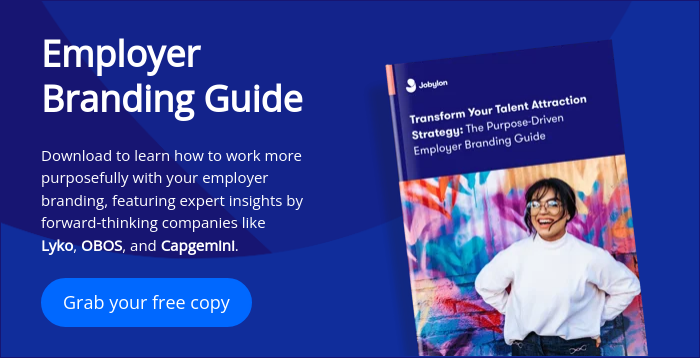Employer branding has evolved from a nice-to-have to an absolute necessity. As the war for top-tier talent intensifies, your company's reputation as an employer can be the deciding factor that tips the scales in your favor. Think of it as your secret weapon in not just attracting but also retaining the most outstanding individuals in the workforce. It's no longer just about the paycheck. Candidates are seeking workplaces that align with their values, offer growth opportunities, and provide a positive culture.
However, employer branding is anything but theoretical. It stands as a discipline that requires meticulous tracking and analysis. Enter Key Performance Indicators (KPIs), the quantifiable metrics that offer invaluable insights into the efficacy of your recruitment strategies. By keeping a close eye on these indicators, recruitment leaders can make data-driven decisions, fine-tune their approaches, and ultimately, elevate their employer brand. So, let's delve into the essential employer KPIs that will help you elevate your recruitment game in 2024.

Why KPIs Matter in Employer Branding
When it comes to recruitment, KPIs are more than mere statistics or numbers displayed on a dashboard. They serve as a mirror, reflecting how effectively your brand connects and resonates with both potential recruits and those already on board. As elaborated in our e-book titled "Transform your Talent Attraction: The Purpose-Driven Employer Branding Guide," it's imperative to understand that these metrics play a pivotal role. They bridge the gap between your brand's narrative and the real-life experiences of your employees and potential candidates, ensuring alignment and authenticity.
Metrics such as candidate satisfaction and the time taken to hire are not just indicators of the efficiency of your recruitment strategy. They also provide a clear picture of how your brand stands and is perceived within the competitive job market landscape.
Advancements in HR technology have made tracking these KPIs more accessible than ever. From instant candidate feedback to comprehensive analytics dashboards, you have the tools to gain real-time insights into your brand's performance. However, technology should complement, not overshadow, the human elements that truly define your brand's strength and appeal. By focusing on KPIs that resonate with your purpose-driven branding efforts, you ensure that your brand isn't just navigating the right course but is also agile enough to make necessary adjustments. This approach not only enhances your brand's market image but also contributes to tangible business outcomes.
7 Essential KPIs to Track
1. Candidate Engagement Rate
Candidate Engagement Rate is a pivotal KPI that gauges the effectiveness of your recruitment marketing efforts and the appeal of your employer brand. This metric is calculated by tracking the number of interactions candidates have with your job postings, social media content, or even email campaigns. It serves as a real-time barometer for how compelling and attractive your employer brand is to potential hires. This means that a high Candidate Engagement Rate not only indicates that your external branding is strong but also suggests that your current employees are likely engaged and satisfied, serving as authentic brand ambassadors.
2. Offer Acceptance Rate
The Offer Acceptance Rate is a crucial KPI that measures the attractiveness of your job offers to prospective employees. This metric is calculated by taking the number of job offers that have been accepted and dividing it by the total number of offers extended, usually expressed as a percentage. A low Offer Acceptance Rate could indicate a disconnect between what candidates are looking for and what your organization is offering, suggesting that your employment value proposition may need reevaluation or better communication. Conversely, a high rate often signifies that your offers are competitive and well-aligned with candidate expectations, making you an employer of choice.
3. Employee Net Promoter Score (eNPS)
The eNPS acts as a useful gauge for measuring the overall contentment of your workforce and their willingness to endorse your company as a great place to work. Obtained through a straightforward survey question that asks employees about their likelihood to suggest the company to peers or friends, the eNPS is determined by taking the percentage of promoters and subtracting the percentage of detractors. A robust eNPS typically indicates a workforce that is not only satisfied but also willing to serve as advocates for your brand, positively affecting both hiring and employee retention. Conversely, a low eNPS can act as a red flag, signaling potential problems that may require immediate intervention, such as an unsatisfactory work environment or non-competitive pay. As such, routinely tracking and scrutinizing your eNPS can offer valuable, actionable data on your organization's well-being from the viewpoint of its employees.
4. Candidate Net Promoter Score (CNPS)
CNPS plays a crucial role in evaluating a candidate's experience and providing insights into your company's reputation as an employer. A strong CNPS not only indicates a compelling employer brand but also facilitates the attraction of high-quality candidates. Furthermore, it can be a cost-efficient approach, potentially reducing your overall hiring expenses. Therefore, if you're looking to refine your recruitment process and enhance candidate satisfaction, make CNPS a cornerstone in your performance tracking toolkit. After all, a happy candidate today could very well be a brand ambassador tomorrow, amplifying your reach in the competitive talent market.
4. Time to Hire
Time to Hire is a crucial KPI that directly impacts your ability to secure top talent before your competitors do. It quantifies the duration from the moment a job vacancy is advertised to the point where a candidate accepts the job offer. This metric is particularly important in industries where skill sets are in high demand and the talent pool is limited. Optimizing the early stages of the hiring process can significantly reduce the overall Time to Hire. A streamlined Time to Hire not only improves the candidate experience but also allows your organization to adapt more quickly to its staffing needs.
5. Quality of Hire
Quality of Hire is a multi-faceted KPI that aims to measure the long-term value a new hire brings to the organization. It encompasses a range of indicators such as performance reviews, turnover rates, and how well the employee climbs the career ladder within the company. This KPI is often considered the ultimate measure of recruiting effectiveness, as it directly correlates with the overall success and growth of the organization. By closely monitoring the Quality of Hire, companies can refine their recruitment strategies to ensure they are attracting and retaining the right talent.
6. Social Media Engagement
Social Media Engagement is an increasingly important KPI in the recruitment landscape, especially as more job seekers turn to platforms like LinkedIn, Twitter, and even Instagram to find opportunities. This KPI tracks the level of engagement—likes, shares, comments, and other interactions—on your recruitment-related social media posts. A high level of engagement not only amplifies your reach but also serves as a testament to the effectiveness of your content strategy. By closely monitoring this KPI, you can fine-tune your social media approach to better attract and engage potential candidates.
7. Cost Per Hire
Cost Per Hire is an essential KPI that provides a comprehensive view of the financial aspects of your recruitment process. This metric encompasses a wide range of costs, including job advertising, recruiter fees, background checks, and even the time spent by internal staff on interviews and evaluations. A lower Cost Per Hire is often seen as a sign of a more efficient recruitment process, but it's crucial to balance this with the Quality of Hire. Cutting corners to reduce costs could lead to poor hiring decisions, which may result in higher turnover and, ultimately, greater long-term expenses. Therefore, it's important to consider Cost Per Hire in conjunction with other KPIs to get a holistic view of your recruitment effectiveness. By doing so, you can make more informed decisions that align both with your budget and your talent acquisition goals.
Conclusion
KPIs serve as invaluable navigational tools that reflect the health and effectiveness of your employer brand. These metrics empower you to make informed, data-driven decisions that not only help you keep pace with competitors but also position you as an industry leader. However, the utility of KPIs isn't a one-time setup—it requires ongoing attention and periodic adjustments to adapt to market changes and organizational needs. As you revel in the successes of your recruiting strategies, never lose sight of these crucial performance indicators. Continuously monitor, analyze, and tweak them to ensure you're maximizing your recruitment efforts. Remember, in the ever-evolving world of recruiting, standing still is synonymous with falling behind.





